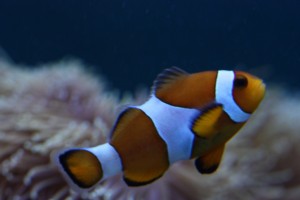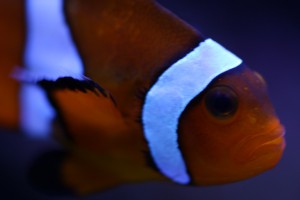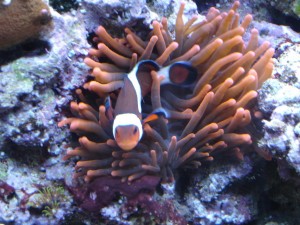Clownfish are a marine and reef aquarium staple with good reason. They are personable, beautiful fish that are friendly enough for most species, but can also hold their own or seek refuge in an anemone in a mildly aggressive set-up. The following article is the first in a series of articles about Clownfish species you might want to consider for your marine or reef aquarium.
The Ocellaris Clownfish, also known as the False Percula Clownfish or False Clown Anemonefish, is found throughout the Indo-Pacific in the wild, but tank bred specimens are currently available for purchase and are recommended. Tank born and raised Ocellaris tend to do very well in the home aquarium, plus it is a sustainable and responsible practice that only adds about three to five dollars to the price of each fish. Ocellaris can attain a length of 4 inches in the wild, but aquarium specimens rarely exceed 3 inches. The advantage of the Ocellaris over the Percula is that it seems to be hardier and it is excellent for the beginner hobbyist.
It is a long-lived clownfish that has been known to live up to ten years. It does well in the presence of anemones such as bubble tip (Entacmaea quadricolor), magnificent anemones (Heteractis magnifica) or carpet anemones (Stichodactyla), but they are not necessary for success.
Although there are no external characteristics to differentiate male and female, other than size, all clownfish are sexually immature when hatched. This means that the fry do not have a pre-determined sex, and develop into males and females depending on the hierarchy of the school. The female is the dominate sex and are larger than the males. In the case that the female leaves or dies and another male is introduced into the home aquarium, there is usually some fighting for dominance, with one turning into the female. If you’re lucky enough to get your clownfish to pair up, a mated pair will lay eggs along the base of a flat rock or surface near a host anemone, using it to protect the eggs. The eggs normally appear orange in color. Without proper preparation, rearing in the average aquarium is nearly impossible. Learning how to successfully breed Ocellaris is an article in itself.
The Ocellaris clownfish is a good eater. I have noticed that on a few occasions, a newly introduced Ocellaris may take a few days before eating. However, almost every Ocellaris I have owned would eat right from my hand, and is usually the first fish to the top of the tank during feeding time. These fish, like most other clown species, will take most meaty foods, flake and frozen herbivore preparations.
Finally, Ocellaris are excellent fish for a reef tank. They do not pick at corals or invertebrates. They do well in tanks as small as twenty gallons, and individually you can have one in a ten gallon, however, I would not go any smaller. Make the Ocellaris a spot in your aquarium and you will not be disappointed.








